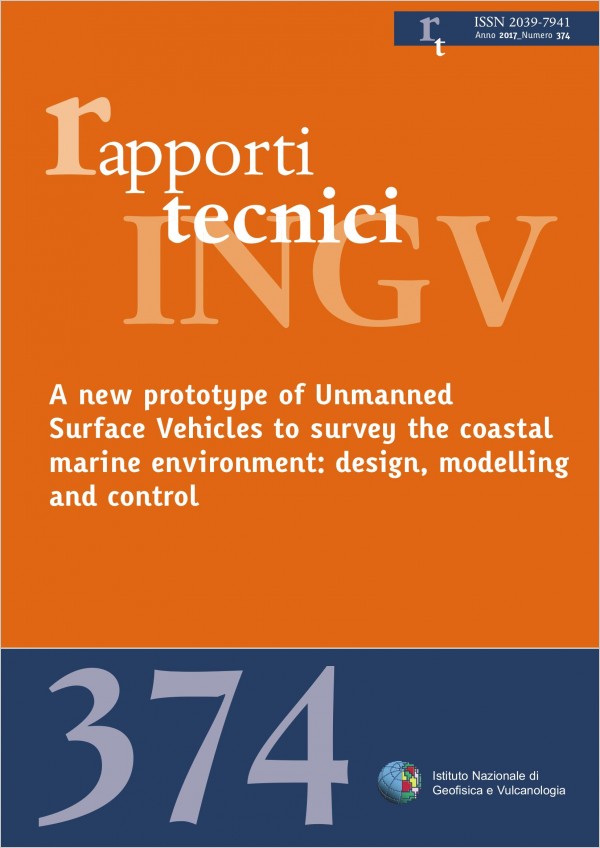A new prototype of Unmanned Surface Vehicles to survey the coastal marine environment: design, modelling and control
Main Article Content
Abstract
In the recent years, Unmanned Surface Vehicles (USVs) have proved their usefulness in particular to collect data for marine research and environmental survey. The use of these controlled remotely platforms, without direct human control, have improved the capacity to image, and monitor the seabed and the costalmarine environment. Outfitted with different instruments (payload), the USVs are used for marine, river and lake activities, such as environmental monitoring, water quality sampling, hydrologic survey, target tracking and scientific survey [Bertram, 2008; Manley, 2008; Giordano et al., 2015]. Other fields of application include harbor surveillance, maritime search, rescue and natural disaster damage assessment [Steimle et al., 2009]. One of the first USV was ARTEMIS, designed in 1993 at MIT (Massachusetts Institute of Technology, Sea Grant Collage) [Manley, 1997] to collect bathymetric data and it was characterized by a propulsion system with two electric motors and a rudder servant-implemented. The USV was equipped by an automatic control of the heading and an autonomous navigation capacity through reference points (waypoints). Its small dimension (about 1.37m long) was the main shortcoming, limiting the endurance and the sea keeping. Following the development of ARTEMIS, to improve the transverse stability and to design more payload capacity and redundancy as regards the buoyancy, MIT adapted the catamaran shape for the hull and removed the rudder; the steering is based on a differential propeller revolution rate. After the MIT, several USVs were designed within many research projects. Among these, other USV were realized. The DELFIM, capable of working in close cooperation with an Autonomous Underwater Vehicles (AUV) [Pascoal et al., 2000] and the ROAZ, ROAZ II, that, set up for bathymetry survey, were designed to allow testing and validation of new developments in monitoring, coordinating multi-vehicle navigation, sampling and other research topics related to marine surface vehicles [Ferreira et al., 2006a, 2009]. Further developed concerned the SWORDFISH, MESSIN and SPRINGER vehicles. The SWORDFISH [Ferreira et al., 2006b, 2007] is a survey vehicle, with modular sensor payloads and a mobile gateway for air to underwater communication. The MESSIN [Majhor and Buch, 2006] is a catamaran dedicated to delivering sensors for oceanographic operations or hydrological mapping. The vehicle is suitable to operate in very shallow water, without destructive effects on the marine environment. The autonomous navigation system allows following the pre-programmed routes efficiently. The SPRINGER was developed in 2004 [Naeem et al., 2006; 2008] for tracking of pollutants, hydrographical surveys in rivers, water resources and coastal waters. As marine platform, SPRINGER was designed to be used also as a test-bed for intelligent navigation systems and for testing of new technologies for the sensors. Several developments in the modelling of twin hull USVs were presented also by the CNR-ISSIA (Italy) [Caccia et al., 2006] that within the SESAMO project designed the catamaran Charlie for sampling activity in the Antarctic Region [Caccia et al., 2006]. This technical report describes an innovative and integrated prototype system of Unmanned Surface Vehicles (USVs) for advanced environmental monitoring; the water platform’s is developed at the Coastal Marine Environmental Institute – National Research Council (Italy), within the Project: Integrated Systems and Technologies for Geophysical and Environmental Monitoring in coastal-marine areas (STIGEAC), in the framework of the National Operational Programs 2007-2013. The project concerns in the research of new technologies and the design of vehicles, for the surveys of the coastal marine environment, understood as a “multipurpose” laboratory for sea research with characteristics of modularity and portability. The goal involves not only the execution of scientific and technological research but also for the valorization of marine cultural heritage, for industrial activity and for emergency interventions related to environmental crises. Major innovations concern the design of a new architecture of the control system and/or to allow the cooperation between heterogeneous unmanned vehicles, the integration of distributed sensing techniques and real-time image processing capabilities [Marsella et al., 2015].
Article Details
Section
Article

This work is licensed under a Creative Commons Attribution 4.0 International License.

